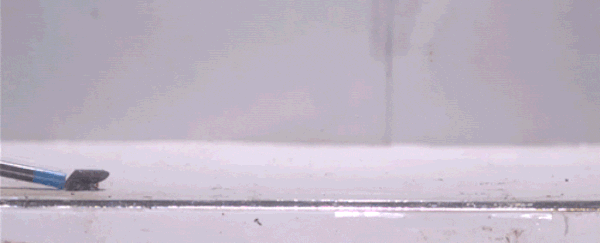Being tiny can certainly have its advantages. You need less food, don't take up as much space, and are harder for predators to spot.
But researchers have just discovered there's a limit to how small a backboned animal can get, while still retaining the ability to balance. Pumpkin toadlets (Brachycephalus) have miniaturized well beyond this limit, resulting in hilariously awkward acrobatics whenever they try to leap.
They crash land on their butts, backs, bellies, and even face – often bouncing before their Skittle-sized bodies finally come to a stop. Luckily the impacts don't appear to harm them.

While frogs are famous for their jumping prowess – some have even perfected this ability to the extent of being able to parachute gracefully through the air – pumpkin toadlets aren't the only professional belly-flopping amphibians. Previous research has suggested frogs' ability to jump evolved before they could actually stick their landings.
Captivated by these toadlets' magnificently comedic tumbles, Southern Illinois University functional morphologist Richard Essner Jr. and colleagues used CT scans of the inner ears of 147 different species to try to pinpoint the issue.
"They're not great jumpers, and they're not particularly good walkers either," explains herpetologist Edward Stanley from the Florida Museum of Natural History. "They sort of stomp around in a stilted, peg-like version of walking."
 Brachycephalus leopardus's awkward limbs. (Ribeiro et al., PeerJ, 2015)
Brachycephalus leopardus's awkward limbs. (Ribeiro et al., PeerJ, 2015)
So, the team checked out the toadlets' legs, and while they only have three functional toes, their springing leg muscles work just fine.
Their jumping technique doesn't explain much either, with futilely reaching, splayed limbs likely hindering their ability to maximize their distance from the threat they're fleeing rather than being any help.
Instead, the trouble was found in their heads.
When we move we rely on feedback from a system of fluid-filled chambers in our ears – our vestibular system – to tell us which way is up. As the liquid sloshes with our movement, fine hairs detect its orientation and speed, providing our brain with information it uses as our positioning system.
Although these frogs still have vestibular organs, they don't appear to be providing the right information for the frog to be able to correct its orientation.
"Even though the canals are as big as they can possibly be relative to their heads, they're still not big enough for the liquid to move at a rate that would allow them to maintain balance," says Stanley.
This is not the only challenge some Brachycephalus have with their ears. At least two species have such underdeveloped hearing equipment they're deaf to their own mating songs.
Their undersized vestibular system not only impedes their ability to land gracefully but makes them very slow and careful walkers too. Luckily pumpkin toadlets spend most of their time hiding in place within the leaf litter of their forested homes in Brazil.
"They're peculiar frogs," says Brazil's Federal University of Paraná zoologist André Confetti. "They can't swim, they don't have tadpoles, and they don't seem to get around much either. We've monitored the acoustic behavior of these frogs and have been able to record the same individual at the same spot over the course of a year."
Instead, these species rely on other means to evade predators. Some are brightly colored and toxic while others rely on camouflage.
"They're not jumping around a lot, and when they do, they're probably not that worried about landing, because they're doing it out of desperation," Stanley concludes. "They get more benefits from being small than they lose from their inability to stick a landing."
Their research was published in Science Advances.
